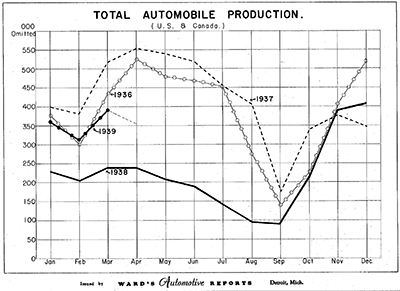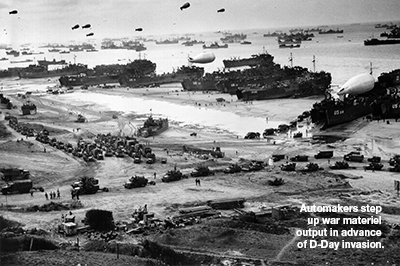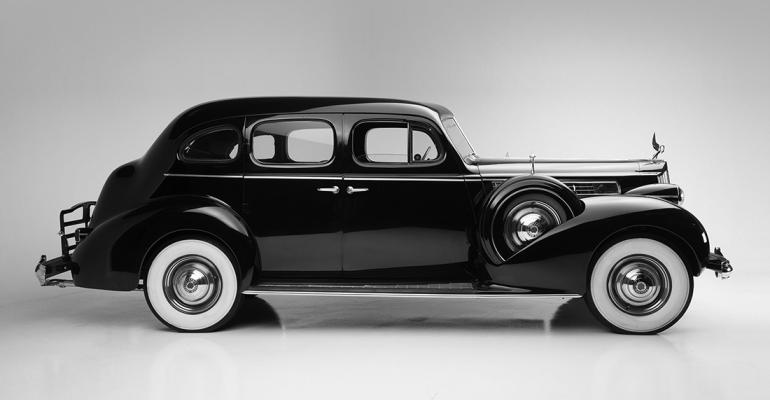75 Years Ago (May 1939): Car Sales Lag; Packard Cuts Prices; Coal Strike Hits Ford; Briggs Workers Walk Out
The “normal” spring upturn in new-car sales has thus far failed to materialize, Ward’s Automotive Reports’ says in its May 6, 1939, issue. Although, poor April weather is blamed for much of the decline, a “noticeable” upturn has taken place in the past week as warmer weather prevails. However, “the underlying strength is not broadening out as would be expected after the rate of winter deliveries, WAR cautions. Lackluster spring sales is prompting production cuts with most plants operating less than a 5-day schedule for the week-ended May 6.
Hoping to stimulate sales, Packard announces price cuts of $10 0 to $300. Rather than a “short-term distress move, the cuts are seen as part of a long-range program designed to entrench Packard in a better competitive position.”
0 to $300. Rather than a “short-term distress move, the cuts are seen as part of a long-range program designed to entrench Packard in a better competitive position.”
Further, the Packard move is not expected to trigger any similar actions across the industry in the near term. “Later, perhaps, if the present size of field stocks continues and sales lag, there may be distress-selling price reductions,” but they will grow independent of Packard’s actions, WAR says.
The effects of a coal industry strike that began in mid-April are at last being felt by Ford’s Rouge manufacturing complex. Although oil is being used temporarily in place of coal to power the Rouge’s electricity-generation plant, the system is not operating at capacity. As a result, “lights were being used as sparingly as possible” during the week-ended May 13.
Other Detroit-area automotive-related facilities also have scaled back operations to a minimum because of coal shortages and will continue to do so until supplies stabilize.
 The late-May walkout of 15,000 workers at the Detroit facilities of automotive body supplier Briggs Mfg. has resulted in the indirect layoff of an additional 55,000 workers in the auto and supplier industries.
The late-May walkout of 15,000 workers at the Detroit facilities of automotive body supplier Briggs Mfg. has resulted in the indirect layoff of an additional 55,000 workers in the auto and supplier industries.
Chrysler, arguably Briggs’ largest customer, accounts for 45,000 of the idled workers. An additional 5,000 are on layoff at Lincoln, 4,000 in supplier plants and 1,000 at shipping and transit companies.
If not settled quickly, the strike will lead to more plant shutdowns and layoffs in the coming week, Ward’s points out in its May 27 issue. However, with Chrysler’s dealers “well supplied” with new cars, there is no immediate pressure, from a manufacturing standpoint, to reach an accord, the newsletter says, “particularly when the CIO-UAW has taken an uncompromising, arrogant attitude with regard to settlement.”
70 Years Ago (May 1944): Industry set for D-Day; Transport Breakdown Imminent; Diesel Popularity Grows; Chrysler Canada Record
“Hot jobs” for the D-Day invasion effort occupy the undivided attention of the auto industry in mid-May 1944. A number of “strange and unaccustomed” problems in design and tooling have been turned over to the industry’s engineering and technical departments and more will be forthcoming as the invasion is launched and the “Allies find what the Nazis have to offer in the way of new defense weapons,” WAR says.
 New types of pursuit and cargo planes, rocket guns and shells, radar equipment and land mines are among the types of equipment auto industry plants are gearing to supply in quantity for the invasion.
New types of pursuit and cargo planes, rocket guns and shells, radar equipment and land mines are among the types of equipment auto industry plants are gearing to supply in quantity for the invasion.
Chrysler’s Canadian facilities are operating at an all-time record pace, running flat-out on two shifts, six days a week. A third shift is employed as needed to meet production schedules that have doubled since 1941. While the plant mostly builds heavy trucks, Dodge and Fargo light trucks for civilian use are in small-scale production as well.
The auto industry hopes that calling attention to an “imminent” breakdown of the transport system in Detroit and other areas with large-scale war production operations will bring some federal government action. At issue are severe shortages of heavy-truck mechanics and drivers. It also is hoped that additional trucks will be released for civilian use.
The automakers say more adequate manpower must be made available to service the growing number of transport trucks tied up for repair.
 An “emergency transport committee” from Detroit is calling upon President Roosevelt and Congress to increase civilian-use truck allotments and to grant draft deferments to experienced truck drivers, claiming it takes two years to properly train inter-city drivers. Many otherwise serviceable trucks are being taken off the roads for lack of qualified drivers, the industry says.
An “emergency transport committee” from Detroit is calling upon President Roosevelt and Congress to increase civilian-use truck allotments and to grant draft deferments to experienced truck drivers, claiming it takes two years to properly train inter-city drivers. Many otherwise serviceable trucks are being taken off the roads for lack of qualified drivers, the industry says.
The diesel engine has gained increasing popularity due to its more widespread use in military vehicles, where it is considered “safer” due to the less-explosive nature of diesel fuel vs. gasoline. Some within the auto industry see the diesel as a threat to the future of the Otto-cycle engine to the extent that, without gasoline-engine improvements, the diesel may become the dominant choice. Arguing against widespread diesel use, WAR notes, are increased weight and less available horsepower at a given displacement.
60 Years Ago (May 1954): 2-Door Hardtop Hits 2.5 Million; OE Tubeless Tires; 12-V Electrics in ’55; 'Composite' Car $2,557.69
The U.S. industry’s all-time production of pillarless 2-door hardtops, first introduced by General Motors in 1949, reached 2.5 million units during the week-ended May 10, 1954.
Buick leads the industry, with production of 471,000 such cars, followed by Chevrolet (413,500) and Ford, where it was introduced on ’51 models, (363,500). So far in 1954, 2-door hardtops account for 15.3% of U.S. car assemblies, up from a record 14.5% in 1953.
 The lowest volume, 9,000 units, has been amassed by Willys, with Hudson’s 10,500 “builds” in second-last position. Only Kaiser lacks a hardtop offering.
The lowest volume, 9,000 units, has been amassed by Willys, with Hudson’s 10,500 “builds” in second-last position. Only Kaiser lacks a hardtop offering.
Leading the industry changeover to 12-volt electrical systems, GM will incorporate it in all ’55-model cars and light trucks, prompting other automakers to convert from 6-volt to 12-volt systems as well.
Sources within the battery industry indicate the switch is likely to be completed by the ’57 model year, at the latest. GM claims the 12-volt system provides more starting power and accessory capability.
Tubeless tires are all but certain to bow as standard equipment on several ’55-model cars, according to comments by officials of U.S. Rubber, GM’s primary tire supplier. The comments were made at the unveiling of the tiremaker’s breakthrough Royal 8 that is priced the same as a tire and tube combination.
Although the tubeless-tire concept dates to 1948, higher prices have been a roadblock to their use as standard equipment, although several manufacturers, including Packard, offer them as optional equipment on ’54 models.
 According to WAR, industry speculation is that all cars will have standard tubeless tires in the ’56 model year. The Royal 8 is engineered for both tube and tubeless applications with the only difference being the tubeless variant comes with a butyl rubber liner to retain the air.
According to WAR, industry speculation is that all cars will have standard tubeless tires in the ’56 model year. The Royal 8 is engineered for both tube and tubeless applications with the only difference being the tubeless variant comes with a butyl rubber liner to retain the air.
Based on a Ward’s analysis, the price of an average or “composite” ’54 model domestic car is $2,557.69, including federal excise tax and dealer prep, but not destination charges. The cost of buying one of every model offered would total $634,306.07, according to the analysis.
The average sticker for the “low price” field is $1,909.90, rising to $4,228.13 in the “high price” segment. Individually, the least costly car, at $1,404, is Kaiser’s Henry J Corsair 2-door sedan, followed by the $1,445 Nash Metropolitan coupe.
The most expensive model on the market is the Chrysler Crown Imperial Limousine at $7,043.75. That beats both the regular Crown Imperial sedan’s $6,921.50 price tag and the $6,090.17 sticker on the Cadillac Series 75 Limousine.
50 Years Ago (May 1964): Ford Planning SUV; Chrysler-Mack Proposed; 4-Speed Trans Growth; Checker Switches Engines
Reportedly, Ford plans to counter International Harvester’s popular Scout utility vehicle with a model of its own, bowing in the ’65½ or ’66 model year. IHC launched the Scout in ’61 and it became the automaker’s best-selling model in 1962.
All-time Scout output totals 100,000 units, including 5,890 in first-quarter 1964. Like Scout, the Ford vehicle is expected to be available in 2- and 4-wheel-drive variants in several cab configurations.
 Chrysler and Mack Trucks have been discussing the possible acquisition of Mack by the No.3 U.S. automaker. According to preliminary details, Mack would be acquired by Chrysler, but continue operating independently through its existing dealer network.
Chrysler and Mack Trucks have been discussing the possible acquisition of Mack by the No.3 U.S. automaker. According to preliminary details, Mack would be acquired by Chrysler, but continue operating independently through its existing dealer network.
Although Mack trucks are predominantly diesel powered, a Chrysler gasoline engine is used in some models. When final details are hashed out, the agreement must be approved by the boards of directors and shareholders of both manufacturers, as well as holders of Mack’s “funded” debt.
The increasing popularity of the 4-speed manual transmission in the growing array of domestic sporty cars has all but kicked to the curb heretofore primary supplier Warner Gear Div. of Borg-Warner as automakers bring production in-house.
 The 4-speed was considered a low-volume specialty item prior to its introduction in the ’62 Chevy Corvair, followed by standard-size Chevrolet and Pontiac models, Corvette and Pontiac Tempest.
The 4-speed was considered a low-volume specialty item prior to its introduction in the ’62 Chevy Corvair, followed by standard-size Chevrolet and Pontiac models, Corvette and Pontiac Tempest.
Warner originally developed the transmission for the ’54 Corvette by adding a fourth gear to its T-85 3-speed manual to create the T-10 4-speed. Warner remained the sole supplier until demand increased to the point it had reached capacity. This year, Ford began building 4-speeds for its V-8 models at its Livonia, MI, transmission plant, while importing units for 6-cyl. cars (Mustang) from England.
Also in ’64, Chrysler is sourcing 4-speeds from its New Process Gear operation in Syracuse, NY, while Chevrolet is meeting its own demand and that of Tempest, Olds F-85 and Buick Special from its plant in Muncie, IN. Warner still supplies 4-speeds used in Buick and Pontiac large cars as well as Studebaker.
 In the ’64 run through Mar. 31, industry installations of 4-speed manual transmissions reached 4.4%, or 219,724 units, up from 3.9%, or 283,452, in the entire ’63 model run. (Nevertheless, Warner’s T-10 will continue to a mainstay in certain high-performances applications, such as the Mustang-based Shelby GT350 and race-ready GT350R as well as the aftermarket.)
In the ’64 run through Mar. 31, industry installations of 4-speed manual transmissions reached 4.4%, or 219,724 units, up from 3.9%, or 283,452, in the entire ’63 model run. (Nevertheless, Warner’s T-10 will continue to a mainstay in certain high-performances applications, such as the Mustang-based Shelby GT350 and race-ready GT350R as well as the aftermarket.)
Checker Motors says its recent switch to Chevrolet I-6 and V-8 engines is prompting increased sales. Previously, Chevrolet sourced 6-cyl. engines from Continental Motors and V-8s from Chrysler. The automaker reports production of the Aerobus (a multi-door macro-stretch version of its station wagon) is sold out through August with orders for its Town Custom Limousine backlogged as well.
25 Years Ago (May 1989): AWD Cars Slow; Ford Hikes Prices; New Geos Coming; Taurus On Top
The market for all-wheel-drive cars may not become as strong as was earlier forecast thanks to the introduction of new technologies, WAR says.
Entire ’89-model-year AWD-car sales now are expected to top out at 110,000 to 115,000 units, down from 123,243 in ’88 and a record 131,924 in ’87. While a decline in new-car sales this year is partly responsible, other factors include the fact several AWD variants are based on models at the end of their production run and thus are less popular in general.
 However, new technologies like ITT Teves’ recently announced electronic traction control, which can easily be adapted to antilock brake systems, offer many of the advantages of AWD, but cost less and reduces weight for better fuel economy.
However, new technologies like ITT Teves’ recently announced electronic traction control, which can easily be adapted to antilock brake systems, offer many of the advantages of AWD, but cost less and reduces weight for better fuel economy.
At the same time, AWD light-truck sales are expected to continue growing as one-time car buyers switch to pickups and SUVs at a rate of about 1.0 million annually for the next several years. Surveys indicate buyers opt for AWD on these vehicles, because of higher resale value, off-road capability and a “macho” look.
Ford is hiking prices of its least-costly and most expensive cars an average 1.5% and the prices of options such as automatic transmission and air conditioning by 3.5%.
 The South Korea-built Ford Festiva now carries a retail sticker of $6,073, up 1.7%, while that of the Mexico-built Mercury Tracer rises 1.3% to $8,672. At the opposite end of the price spectrum, the Lincoln Continental now costs $28,465, an increase of 1.5%.
The South Korea-built Ford Festiva now carries a retail sticker of $6,073, up 1.7%, while that of the Mexico-built Mercury Tracer rises 1.3% to $8,672. At the opposite end of the price spectrum, the Lincoln Continental now costs $28,465, an increase of 1.5%.
Chevrolet plans to introduce new models in its Geo-brand small-car lineup in model year ’90. Coming this fall is the Geo Storm front-drive sporty hatchback, manufactured by Isuzu, that replaces the slow-selling Isuzu-built Spectrum sedan and hatchback. A 2-passenger convertible variant of the diminutive Metro hatchback will be imported from Suzuki beginning in January 1990.
Ford Taurus remains the top-selling car in the U.S. through May 1989, even as Chevy’s Beretta/Corsica battles for second place with Ford’s Escort.





